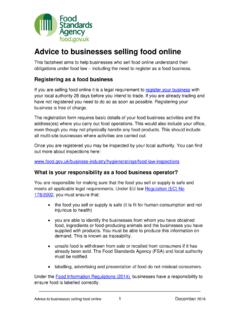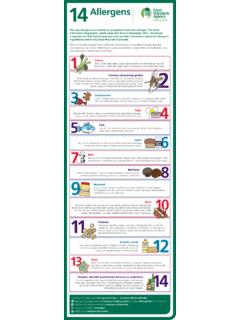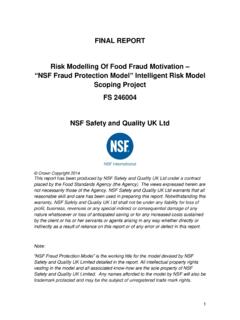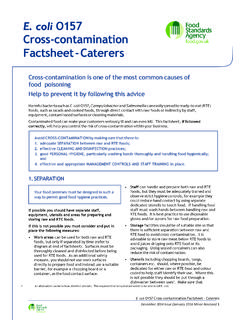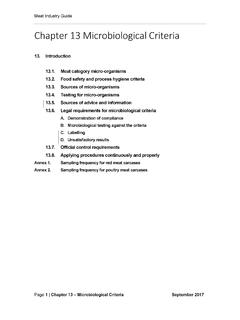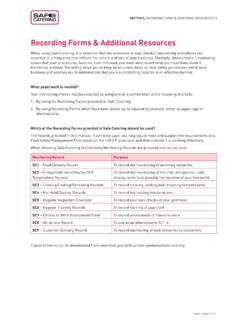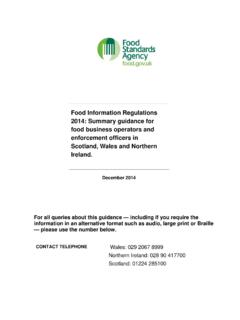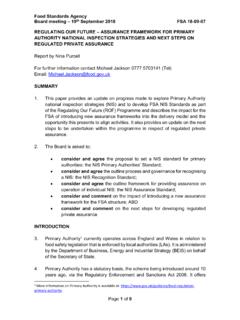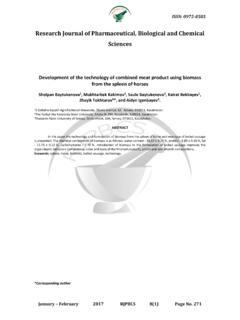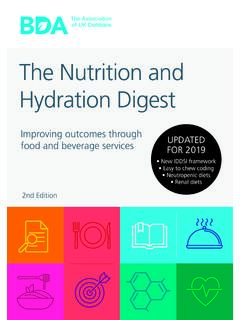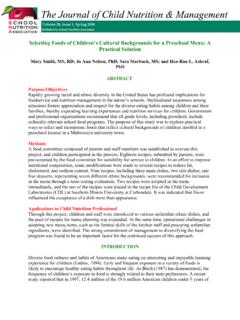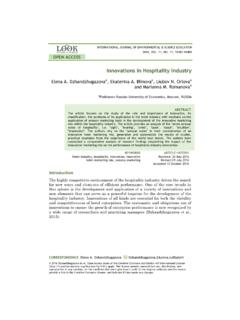Transcription of The lived experience of food insecurity under Covid-19
1 The lived experience of food insecurity under covid -19A Bright Harbour Collective Report for the food Standards Agency Caitlin Connors, Laura Malan, Siobhan Canavan, Fan Sissoko, Maria Carmo, Claire Sheppard & Fran Cook July 2020 Contents Executive Summary i-iii Introduction Key findings What next? Chapter 1: Introduction 1 food insecurity & Covid-19 : same storm, different boats 1 Our approach 2 Chapter 2: Journeys to food insecurity 3 Journeys of the newly insecure 3 Experiences of those already food insecure 3 Covid-19 quickly magnified existing financial and other vulnerabilities 4 Covid-19 presented new challenges to budgets - expenses increased, food became more expensive to access, and workarounds failed. 4 Chapter 3: Navigating support 5 Friends, family and community are a preferred support option, but not all that needed support asked for it.
2 Admitting the need for help is hard 6 Access, eligibility and sufficiency issues have reduced the impact of formal Covid-19 financial supports for many 7 Many experienced school vouchers access and journey barriers 8 Many were unaware of the breadth of food -specific support options available - and stigma remained a huge barrier to access 8 Universal Credit support helped many - but payment complexity, delayed payments, access issues and benefits amounts left gaps 9 Chapter 4: The complex and layered impacts of food insecurity under Covid-19 11 The impact of food security on calorie intake, diet and nutrition 11 The impact of food security on physical health 12 The impact of food security on emotional wellbeing and mental health 13 The impact of food security on commensality 15 Chapter 5: What next? 16 Chapter 6: Real life - case studies 17 2 Executive Summary Introduction This report presents a snapshot of lived experiences of food insecurity under Covid-19 , based on qualitative research with 20 UK citizens conducted in June 2020.
3 Our sample represented a range of variables including age, gender, lifestage and household composition, health and mental health status. Half were food insecure pre- Covid-19 , half after. We aimed to build on existing evidence on food insecurity - focusing on insecurity experiences under Covid-19 and lockdown specifically. Key questions included: How are people experiencing food insecurity under Covid-19 ? What are the impacts of food insecurity under Covid-19 ? How are food insecurity and mitigating supports being navigated? Key findings 1. Income loss has rapidly exacerbated existing insecurity and vulnerabilities Covid-19 rapidly worsened insecurity for those who were already missing meals and/or compromising nutritional quality previously, and rapidly tipped those just managing into insecurity . Established tactics for stretching limited incomes and food budgets failed as income reduced; there was little left to cut except food itself.
4 For many, food insecurity and Covid-19 were managed alongside other challenges: job insecurity /job loss, caring responsibilities, health/mental health issues, domestic violence, debt, and so on. Drivers of risk and vulnerability included: The inability to build and draw on financial safety nets - low-paid work, zero hours contracts, mixed self-employment/salaried work, and/or work in unpredictable sectors left people financially exposed under Covid-19 Working without full time, reliable salaries - including key workers such as teaching assistants, social care professionals, and family support workers. Working in sectors that could not move remote when Covid-19 hit - manual labour; personal services; etc. Caring responsibilities which limited income potential and raised outgoings - particularly but not only for women and single parents. Health and mental health challenges - 70% were experiencing chronic health issues prior to Covid-19 ; 65% long-term mental health issues.
5 Domestic violence and abuse - several had recently fled partners who had become abusive, and were unexpectedly now raising children alone. 3 2. The impacts of Lockdown/Covid19 on accessing affordable food Many participants faced rising basic costs under Covid-19 and lock-down: increased costs for caring for parents or children at home; rising utility bills; rising electricity spend; etc. food had also become more expensive for almost everyone we spoke to. Spend had doubled or tripled for some even as they ate much less, due to: Elimination of social food sharing - many had previously counted on meals with others ( a family Sunday roast) to stretch their weekly food budgets. Struggling to afford supermarket delivery fees - , if isolating; c. 4- 6 for grocery deliver is a big percentage of a 25/ 30 weekly food budget. Reduced access to budget shops and not being able to bargain shop - the inability to reliably access preferred supermarkets increased costs.
6 Increased competition for value and budget brands - cheaper items were often already taken by others, leaving only expensive branded items. Price increases by shops which charged more for basics when Covid-19 hit. Relying on others to help with food shopping - but feeling too ashamed to dictate brand choices or supermarket choice, raising spend. 3. Impacts of food insecurity under Covid-19 were multilayered and complex Impacts reached far beyond missed meals: participants were experiencing complex and interlocking physical, emotional, social and financial challenges: Caloric intake, nutritional quality and variety had reduced - Many were subsisting mostly on tinned food , frozen food , or simple carbohydrates (bread, pasta and rice). Many were skipping meals and going hungry regularly. Some showed potential signs of malnutrition - for example, regularly feeling fatigued, sluggish or poorly.
7 Many were putting on weight, even as they ate much less, raising concerns about links between obesity and Covid-19 s more severe symptoms. Stress, anxiety, overwhelm and depression were serious issues for many; well-being suffered, and existing mental health issues worsened. Many with food intolerances were unable to afford foods used to manage their health ( , gluten free), with negative physical and emotional impact. Some were compromising on food safety - stretching labelling advice around use-by dates, raising risks of food poisoning. People lost the small comforts that provided a sense of stability under Covid-19 ; eating only for basic sustenance Some spoke of reduced family contact time over meals: there was little sense of social sharing when serving toast for a second meal of the day. Celebratory meals, like birthdays or Sunday dinners, were cancelled - eliminating small pleasures that would otherwise provide useful distraction.
8 food insecure parents were particularly affected, juggling many financial and emotional challenges daily. Managing food insecurity , Covid-19 , income loss and other stresses for themselves plus their children was a heavy burden. 4 4. Access, eligibility, and awareness issues: many that need help hadn t received it Social support from friends, family and community were critical for many, and more formal financial and food supports had also helped some. However, most of the food insecure people we spoke to had accessed no help, limited help, or insufficient support for their level of need. Most were unaware of community/charity schemes available - and many who were aware did not access them. Stigma and a desire to leave those services for people that need them most were strong barriers to use. food banks had high awareness but low use due to stigma.
9 food boxes were a source of embarrassment and stigma though gratefully received; some raised concerns about the nutritional quality of food provided. Many were unable to access Universal Credit, or were still going hungry with support. People with complex income seemed to be particularly vulnerable ( , zero-hours contracts, mixed employment/self-employment). Supports like furlough, mortgage/rent holidays, and business support made a big difference to some - but many weren t reached. Gaps in furlough support were pronounced for those not working full time. What next? Most we spoke to were optimistic about or not thinking about the future, focused on making it through the next weeks or months. However, many were in industries and positions that may experience further disruption or uncertainty - dog walking, cruise ship hospitality, hairdressing, teaching assistants, etc.
10 If income disruption continues, and mitigating support (such as furlough) does not, people already food insecure will face worsening challenges: Many have taken on or increased debt under Covid-19 that will need repaying, but do not have certainty about income returning Those who had small savings funds in March have now spent them. Personal reserves are low: many are feeling poorly physically and emotionally, and are likely more vulnerable to further strain. Younger people have lost opportunities and momentum - eating into savings meant to help move out of home, obtain degrees, start families, etc. Rising utility bills during the winter period will increase hardship for Chapter 1: Introduction food insecurity & Covid-19 : same storm, different boats After months of living with Covid-19 , it is already easy to forget the uncertainties, anxieties and fears of Spring 2020, as relied-on routines, social connections, and stabilities evaporated.
